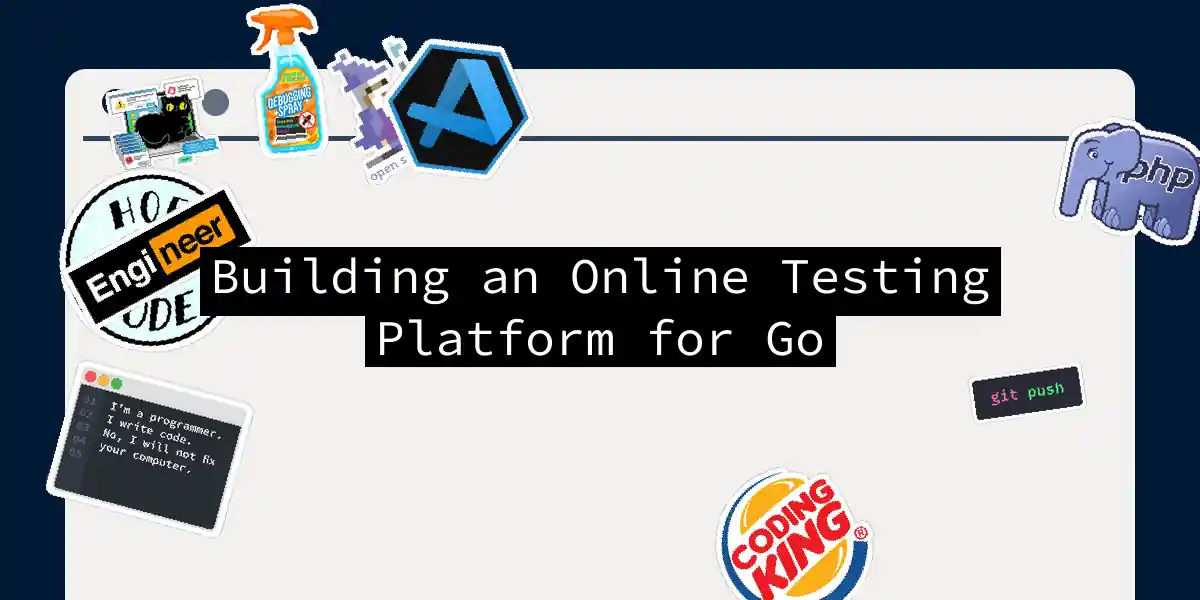Introduction to Online Testing Platforms
In the era of remote work and digital learning, online testing platforms have become indispensable tools for assessing skills and knowledge. For Go developers, having a platform specifically designed for testing Go skills can significantly enhance the hiring process and skill assessment. In this article, we’ll explore how to build such a platform, focusing on practical steps and code examples.
Understanding the Requirements
Before diving into the development process, let’s outline the key features our platform should have:
- User Registration and Authentication: Users should be able to register and log in securely.
- Test Creation and Management: Admins should be able to create, manage, and categorize tests.
- Test Execution and Evaluation: The platform should execute tests and provide immediate feedback.
- Code Editor and Execution Environment: A built-in code editor where users can write and execute Go code.
Architecture Overview
Our platform will consist of several components:
- Frontend: Handles user interaction, including registration, test selection, and code editing.
- Backend: Manages user data, test creation, and execution.
- Database: Stores user information, test questions, and results.
Here’s a high-level overview of how these components interact:
Step-by-Step Implementation
1. Setting Up the Backend
We’ll use Go for the backend, leveraging its built-in net/http package for handling HTTP requests and the database/sql package for database interactions.
First, let’s set up a simple server:
package main
import (
"database/sql"
"fmt"
"net/http"
_ "github.com/mattn/go-sqlite3"
)
func main() {
// Initialize database connection
db, err := sql.Open("sqlite3", "./test.db")
if err != nil {
panic(err)
}
defer db.Close()
// Define routes
http.HandleFunc("/register", registerUser(db))
http.HandleFunc("/login", loginUser(db))
http.HandleFunc("/tests", getTests(db))
fmt.Println("Server is running on port 8080")
http.ListenAndServe(":8080", nil)
}
func registerUser(db *sql.DB) http.HandlerFunc {
return func(w http.ResponseWriter, r *http.Request) {
// Handle user registration logic here
}
}
func loginUser(db *sql.DB) http.HandlerFunc {
return func(w http.ResponseWriter, r *http.Request) {
// Handle user login logic here
}
}
func getTests(db *sql.DB) http.HandlerFunc {
return func(w http.ResponseWriter, r *http.Request) {
// Handle retrieving tests logic here
}
}
2. Creating a Test Execution Environment
To execute Go code, we’ll use the os/exec package to run the Go compiler and execute the compiled binary.
package main
import (
"bytes"
"fmt"
"os/exec"
)
func executeGoCode(code string) (string, error) {
// Create a temporary file for the Go code
tmpFile, err := os.CreateTemp("", "go-")
if err != nil {
return "", err
}
defer os.Remove(tmpFile.Name())
// Write the code to the file
_, err = tmpFile.WriteString(code)
if err != nil {
return "", err
}
err = tmpFile.Close()
if err != nil {
return "", err
}
// Compile and run the code
cmd := exec.Command("go", "run", tmpFile.Name())
var out bytes.Buffer
cmd.Stdout = &out
err = cmd.Run()
if err != nil {
return "", err
}
return out.String(), nil
}
3. Integrating a Code Editor
For the frontend, we can use a library like Monaco Editor to provide a rich code editing experience. Here’s a basic setup using HTML and JavaScript:
<!DOCTYPE html>
<html lang="en">
<head>
<meta charset="UTF-8">
<meta name="viewport" content="width=device-width, initial-scale=1.0">
<title>Go Code Editor</title>
<link rel="stylesheet" href="https://cdn.jsdelivr.net/npm/[email protected]/min/vs/loader.css" />
</head>
<body>
<div id="editor" style="width:800px;height:600px;border:1px solid grey;"></div>
<script src="https://cdn.jsdelivr.net/npm/[email protected]/min/vs/loader.js"></script>
<script>
require.config({ paths: { 'vs': 'https://cdn.jsdelivr.net/npm/[email protected]/min/vs' }});
require(['vs/editor/editor.main'], function() {
monaco.editor.create(document.getElementById('editor'), {
value: [
'package main',
'import "fmt"',
'func main() {',
' fmt.Println("Hello, World!")',
'}',
].join('\n'),
language: 'go',
theme: 'vs-dark'
});
});
</script>
</body>
</html>
4. Implementing Test Creation and Management
Admins should be able to create tests with multiple-choice questions or coding challenges. We’ll store these tests in our database.
func createTest(db *sql.DB, testName string, questions []string) error {
// Insert test into database
_, err := db.Exec("INSERT INTO tests(name) VALUES(?)", testName)
if err != nil {
return err
}
// Insert questions into database
for _, question := range questions {
_, err := db.Exec("INSERT INTO questions(test_id, question) VALUES((SELECT id FROM tests WHERE name = ?), ?)", testName, question)
if err != nil {
return err
}
}
return nil
}
5. User Authentication and Authorization
To ensure only authorized users can access certain features, we’ll implement authentication using sessions or JWT tokens.
func authenticateUser(db *sql.DB, username string, password string) (bool, error) {
// Query database for user credentials
row := db.QueryRow("SELECT password FROM users WHERE username = ?", username)
var storedPassword string
err := row.Scan(&storedPassword)
if err != nil {
return false, err
}
// Compare passwords
if storedPassword != password {
return false, nil
}
return true, nil
}
Conclusion
Building an online testing platform for Go involves several steps, from setting up the backend and database to integrating a code editor and implementing user authentication. By following these guidelines and examples, you can create a robust platform that meets your needs for assessing Go skills. Remember, testing is not just about evaluating code; it’s about ensuring that your platform provides a seamless user experience.
As you embark on this project, keep in mind that practice makes perfect. Don’t be afraid to experiment and learn from your mistakes. Happy coding
